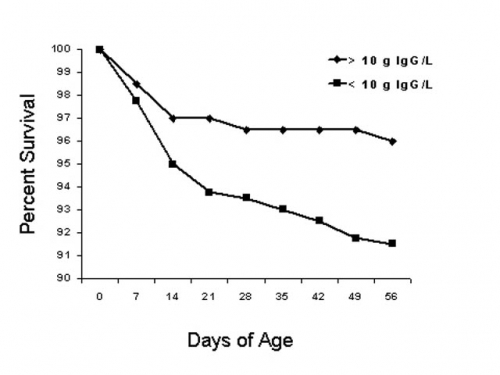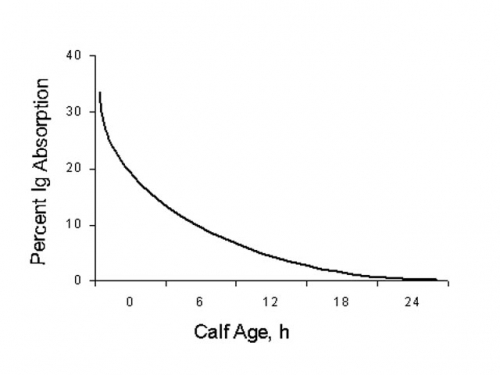Colostrum is liquid gold for newborn calves
Colostrum makes the difference in life and death for calves.
The immunity a calf attains by consuming colostrum is called passive immunity. Passive immunity is received from an outside source. Newborn calves achieve passive immunity by consuming colostrum shortly after birth, thus providing essential proteins called immunoglobulins (Ig).
Attainment of adequate passive immunity is often associated with blood IgG concentrations greater than or equal to 10 g/L at 24 hours of age. The incidence of calf death is increased when blood Ig levels fall below this threshold (Figure 1). Absorption of Ig must occur before the calf's intestine becomes impermeable to the large Ig proteins. The development of impermeability is called gut closure. Typically, a healthy calf that has access to liquid feed or has consumed colostrum will undergo complete gut closure by about 24 hours after birth (Figure 2).

Figure 1. Effect of passive immune status (blood immunoglobulin concentrations) on newborn survival

Figure 2. Effect of age of calf on the percent absorption of immunoglobulin through the calf intestine.
Immunoglobulin may be fed to calves using a nipple bottle or an esophageal feeder. Healthy calves should consume three to four quarts of colostrum within twelve hours of birth. The esophageal feeder is a long, narrow, rigid tube that is inserted down the esophagus of the newborn calf. A bottle or bag attached to the other end of the tube contains the fluid that flows into the calf upon release.
Producers may wish to have a stored supply of quality colostrum available. This can be achieved by freezing high-quality colostrum collected from the first milking after calving. The concentration of Ig in colostrum is a common indicator of colostral quality. Colostrum containing greater than 50 g Ig/L is considered to be high quality. Colostrum may be stored frozen for up to a year with no significant loss in Ig. Measuring colostral quality on the farm can be achieved by the use of a colostrometer. The colostrometer is a hydrometer device calibrated to associate specific gravity of colostrum with Ig concentration. When using this instrument, it is critical to control the temperature of the colostrum being tested. Variations in colostrum temperature impact specific gravity. To avoid Ig destruction, it is important not to overheat frozen colostrum during thawing. A good practice to follow is to submerge the sealed, frozen container in a bath of warm (not hot) tap water until it thaws completely. Thawing time will vary depending on container size. Storing two quarts in a one-gallon sized freezer bag laid in the freezer allows for quick thawing at this critical time.
Important Considerations in a Colostrum Management Program
- The ability of calves to absorb Ig fall drastically after 12 hours and is totally blocked 24 hours of age.
- All calves should consume within the first 3 hours after birth, consuming 3-4 quarts by 12 hours of age.
- If the calf cannot nurse, always attempt to use high quality frozen or fresh colostrum (minimum of 50 g of IgG/L). If colostrum availability is limited, use a bovine-serum based commercial supplement either to fortify an existing colostrum source or to replace colostrum when none is available.
Healthy newborn beef cow/calf pairs can manage colostrum consumption quite well when left unattended. When deciding whether or not to hand-feed colostrum to a newborn beef calf, ask yourself the following questions:
- Is the calf too weak to suckle soon after birth?
- Has the cow abandoned the calf or refused the calf access to suckle soon after birth?
- Has the calf experienced a difficult birth or been exposed to bad weather that might interfere with its ability to suckle?
If you answered yes to any of these questions, you may decide to force-feed colostrum to the calf. First, attempt to use colostrum from the calf's mother. If this is not available, use stored dairy colostrum or a colostrum supplement. Under grazing situations, it is best to administer a single fluid feeding so that the calf is handled only once. In this case, it is important to use an esophageal feeder. The esophageal feeder will allow a 2-quart volume to be easily administered. This volume is not excessive for the calf, but will allow a large amount of Ig to be administered in a single fluid feeding. Consult your local veterinarian for calf health problems not addressed in this article.
For additional cattle management resources, visit the MSU Beef Team website.



 Print
Print Email
Email

